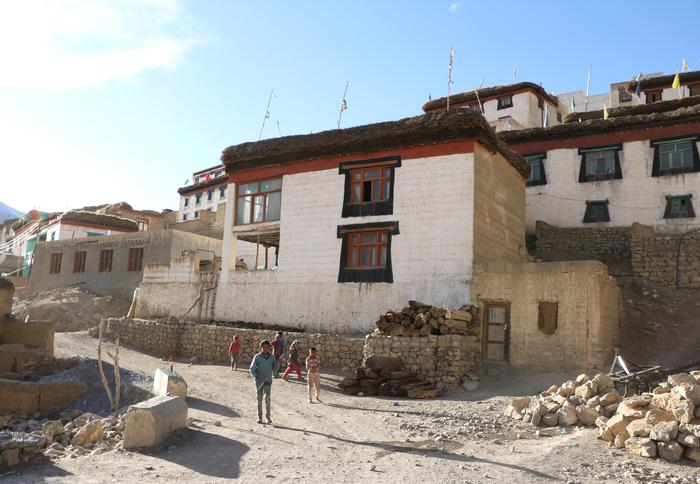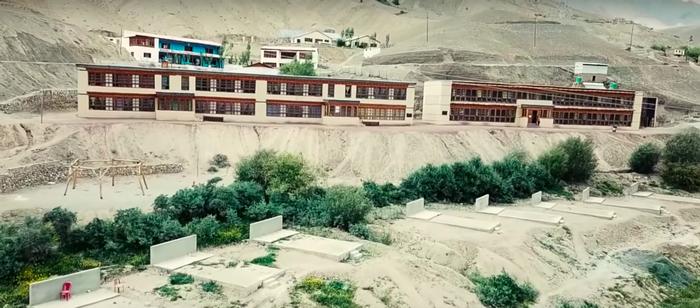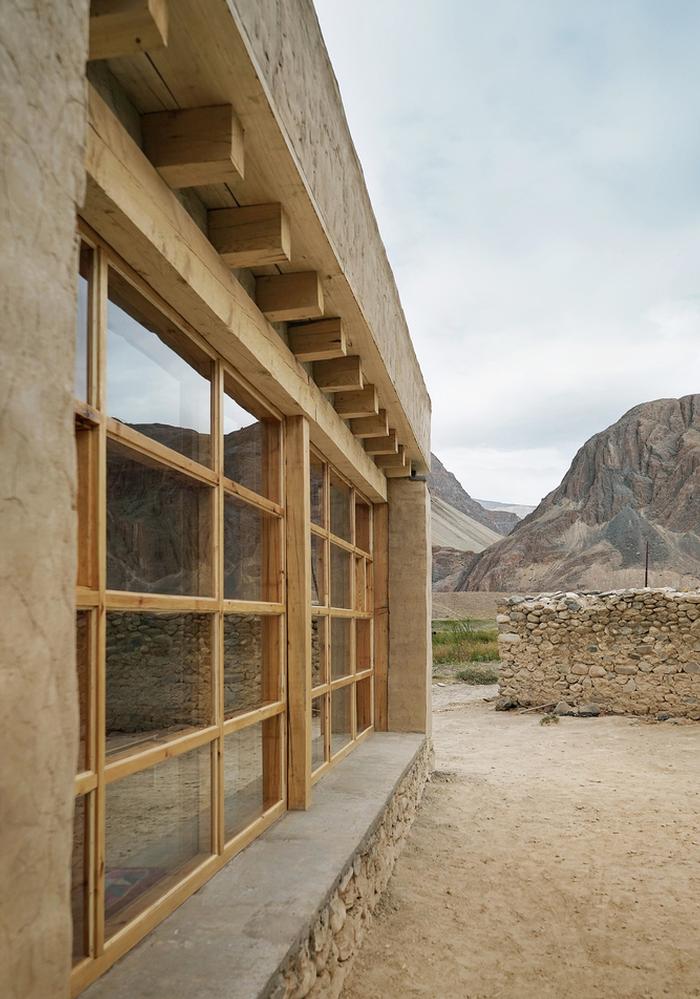Chiranjivi Jai Mankoo and Samriddhi Pandey EssayAdapting Traditions In The New World Order“If Nature had been comfortable,mankind would never have invented architecture” Oscar Wilde Not everyone gets to go on an arduous spiritual journey to find themselves and to witness the undying spirit of human resilience in the face of harshest adversities.Our calling led us to the Land of the High Passes, Ladakh, home to one of the most isolated indigenous mountain communities of the world.Travelling to one of most remote parts of the world which has been continuously inhabited by humans was a life-transforming experience,a spiritual pilgrimage that compelled us to unravel the mysticism and spiritualism this land had to offer. The rough and winding road leading to the ancient kingdom of Ladakh’s capital Leh was surrounded by moss green pine forests of Kashmir to the Zoji-la pass,acting as a dramatic boundary.As we approached,bare earth could be seen in the parched rain shadow of the Himalayas.We were welcomed by scenic mountains in every direction and vast plateaus of crests in warm and varied tones from rust to pale green.Above,snowy peaks reached towards a still,blue sky;below,sheer walls of wine-red scree fell to stark lunar valleys. And it just made us wonder how life can sustain and thrive in this wilderness where everything is barren;every single step we took sends up a cloud of sand and dust. But slowly and gradually our eyes began to comprehend what they saw and brilliant green oases came into focus like emeralds set in a vast brown cold desert.Fields of barley appeared,fringed with wildflowers and herbs and the clear waters of glacial streams.Above these fields sat a cluster of traditional Ladakhi houses hung with finely carved balconies with brightly coloured Buddhist prayer flags fluttering on the rooftops.Higher still,perched on the mountainside,Tsamo Gompa Monastery watched over the villages of Old Leh Town,as if almost protecting it.Wandering through the fields or following the narrow paths of Old Leh,we were greeted with smiling faces of Ladakhi natives, children and Mahayana Buddhist Monks leading a fulfilled life dictated by seasons more so, than in almost any other inhabited place on earth.Scorched by the sun in summer,the entire region freezes solid for eight months in winter,when temperatures drop to as low as minus forty degrees and gets cut off from the rest of the outside world.Ladakhis face the fiercest of climates: winds whip up tornadoes along the empty corridors of the desert; rain is so rare that it is easy to forget its very existence. Funnily enough, it rings quite true when the Ladakhis say “Our land is so barren and our passes so high that only our best friends or our fiercest enemies would want to visit us.” And enemies,they, unfortunately, have many.No stranger to frequent natural disasters like earthquakes and landslides and strong military presence of the Indian Army due to its strategically important location due to border tensions between Pakistan and China,Ladakh indeed is the Land of the Extremes. Roaming the narrow steep lanes of old Leh, we noticed the vertical stacking of the traditional houses on the slope of the hill facing southwards, forming a concave urban surface and sharing walls on two or three sides to prevent heat loss due to exposed facade.Critical examination of a typical traditional ladakhi house made us realise that they illustrate a highly evolved traditional understanding of manipulating the extreme climatic conditions through vernacularity by only using locally available material.Ancient texts documenting traditional building techniques do not exist and all traditional knowledge has been passed down by the ladakhi ancestors for generations after generations for hundreds of years. Typically,Village houses are large structures two or three floors high,with a floor area of four thousand square feet or more.Whitened walls slope gently inward toward a flat roof, giving the house grace despite its massive, fortress-like proportions.A new house is never built without concern for the Sadak, the spirits of the earth blessed by the high lama.Although stone is often used for the first floor, the main building material is mud.Mud is the key element for construction due to its easy availability along with its compatible thermal and structural properties.Together the whole family prepares the bricks;even small children join in putting mud into the wooden moulds.As soil varies from village to village,practices differ:sometimes larger bricks are made,sometimes straw is added to the mix which is then sun-dried.Walls are often three feet thick,plastered with a fine clay called markala (literally, “butter-mud”) and then whitewashed with limestone.We noticed that Poplar beams,with willow branches placed in a herringbone pattern across them,formed the flat roof due to lack of rainfall. Yagdzas, a local shrub-like heather, which is said to last for a hundred years, lay on top of the wood and was packed with mud and earth, thus, assisting in the insulation. The house is more than just functional; time is spent on details that are purely aesthetic depicting Buddhist beliefs.Timber frames that have proven to be earthquake resilient are used for windows and doors which receive special attention and detailing.Ornately carved lintels by the village carpenters is typical in the ladakhi houses where the most popular design is the lotus.A jet black border,about ten inches wide and made from a mixture of soot and clay,contrasts with the white walls and acts as thermal barrier.Finely worked ornate balconies graced the upper floor.The entrance to the house faced east,a tradition considered auspicious.A stone stairway took us straight up to the first floor,the ground floor served as a stable for the livestock.The ground floor had no windows but only slits for ventilation and to prevent dispersion of heat.This way,in the winters the animals not only stayed protected but their body heat gets transferred to the upper floors and together with the fireplace of the living room becomes the part of the heating system of the house. Beyond the entrance-way stretches the kitchen, which,together with the attached storage rooms, took up most of the first story;above us,light beamed in from a large courtyard on the second floor.The sun itself doesn’t realise how wonderful it is until after a ladakhi house is made.Kitchen being the heart of the house is usually so large that it can be difficult to talk to someone on the other side of the room, combining the functions of the living and bedroom.Other than a few low tables and mats, there is little furniture; two-thirds of the floor area is left completely uncluttered.Along one wall, a row of ornate wooden shelves is filled with a dazzling array of pots of every size.A large, shiny black clay stove is the focal point of every kitchen.The fire is fed with dried dung and kept alight with goatskin bellows.Much of the house is given over to storage, as for more than six months of the year nothing grows outside.Off the kitchen is the main storeroom, its thick walls ensuring that it stays icy cool in the heat of summer. The roof is stacked with alfalfa grass for the animals and shrubs and dung for the kitchen stove.In the summer,yak-hair blankets are always spread out on the roof,with vegetables,apricots and sometimes cheese drying in the sun. On the top floor, surrounding the courtyard,are usually two or three rooms—typically the guest room,a summer bedroom, and the family “chapel,” the most elaborate and expensive part of the house. The rooms are usually carpeted to capture heat.The “chapel” is filled with religious texts and other treasures that have been passed on for generations.Worn thankas (religious paintings on cloth) covered the walls and a large drum hanged from the ceiling where family made offerings by lighting the oil-filled lamps,filling the bowls with water,and chanting mantras and prayers.Despite an extreme climate and a scarcity of resources,Ladakhis enjoy more than mere subsistence—an achievement all the more remarkable since people have only the most basic tools to work with. It didn’t take us long to register that the houses were quite energy efficient in a traditional way.With scarce resources at their disposal, they truly believe that there is enough for everyone’s need but not for everyone’s greed.The ladakhi household is self-reliant,with almost no waste generation.Their livestock gives them wool as well as dung as fuel and waste is generally biodegradable.Simplicity of lifestyle and easy-going nature of the people has enabled them to survive.Tradition has taught the ladakhis passive design strategies that has enabled them to harness and use harsh weather as an ally especially taming the sunlight by adopting passive solar techniques such as placement of large fenestrations in the south facing facade. Ladakhi vernacular architecture is a true expression of its values, a value system where community inclusivity is at its core and Mother Nature is considered divine.Our quest to find a contemporary building that had successfully learnt to survive this climate led us to Mulbekh,a small village in Kargil,site of the Indo-Pak War of 1999,another district in Ladakh.And we found our answer in the form of new block of Spring Dales Public School,built in 2014 by the collaborative efforts of hundreds of local ladakhis and Czech architectural firm Archide.The project was headed by the local hero Tsewang Norboo.Through his relentless efforts and vision,the school received not only blessings from His Holiness The Dalai Lama but also financial funding from The Dalai Lama Trust Fund,New York. At first glance,the sleek and elegant form of the school building against the backdrop of The Great Himalayas looked almost poetic and artistic,standing like a true testament to the resilience not only of the mud bricks but of the ladakhi people and their determination to provide quality education for the future generation.The locals under the guidance of Norboo and architect Knap had designed for the present with an awareness of the past for a future that is essentially unknown. Handling the ecological context with utmost fragility and care they conceived the school as an entirely sustainable project carving out spaces that were simple,flexible and comfortable while celebrating local traditions,materials,techniques, and skills.Their site strategy aimed to ensure a complete self-regulated system of water,energy and waste management to minimise carbon footprint.Deeply rooted in vernacular values and soaked in contemporary techniques that are climate responsive,the building was made using indigenous materials like stone,mud mortar,mud bricks, and timber. Surrounded by landscaped gardens that serve as outdoor teaching area as well as breakout space for the kids,it was fascinating for us to notice how this school building had taken inspiration from a typical ladakhi house which was reflecting in its spatial arrangement.Placement of classrooms with low ceilings on the ground floor and the residential dorms on the first floor both fully double-glazed south facing facades which permitted sunlight as horizontal beams,reflecting off the white painted mud rendered walls with timber floors made the interiors seem serene and assisted in the solar heat gain along with natural ventilation.Transitional spaces and unoccupied spaces like circulation and storage were placed on the north side of the building,and entrance halls were used as buffer zones to reduce heat loss.Employment of time tested traditional techniques such as mud plastering and Trombe walls helped in capturing heat in the winters. To infuse ancient traditional vernacular techniques in modern context while constructing the school, various tests were carried out to identify and rectify the inadequacies of the traditionally used materials and techniques and necessary adjustments were made.Norboo informed us that while constructing the school,they identified the mud wall’s inherent thermal and structural capabilities but it gave imprecise and inconsistent results and often resulted in cracking,and hence they devised a reinvented construction technique where framework of mud walls was strengthened by using waterproof plywood and steel struts to achieve a rigid surface for a consistent result and the mud mixture was reformulated by removing some clay to eliminate wall shrinkage and to achieve required strength.This enabled them to achieve precise wall connections and crisp aesthetics.Along with use of timber frames as they are earthquake resistant. The buildings’ wall sections were designed to accommodate for seasonal changes and the time of day,segregating the program into “day-use” and “night-use” functions where “day-use” spaces took advantage of direct heat gain through employment of large windowed walls with louvred overhangs to allow light and heat to penetrate deep into the space during the winter while “Night-use” spaces pushed more of the thermal mass to the building’s south-facing wall,where it accumulated heat throughout the day and slowly released the heat inside after the sun had set for dorms. What brings character and integrity to the school building is not the materials or its modern construction details but its little students.Intelligent far beyond their small age, undeterred by the challenges posed by circumstances and climate,they along with Norboo have managed to make their school self-reliant in a region of limited resources.Incorporating solar composting toilet, which uses the sun’s energy to create a ventilation chimney as well as solar panels for electricity generation,they have made the school self-reliant.Churchill rightfully said, ‘We shape our buildings;therefore,they shape us.’ Efforts of a few has helped shape the children of the whole village who hope to be the architects of the future and not its victims.Teaching them traditions and modernity through example. According to the natives,failure of buildings that haven’t incorporated traditional vernacular techniques and values in an attempt to modernize and cater to the unchecked wave of tourists while playing a mindless imitation game of western architectural styles has disturbed the fragile balance of survival and nature in Ladakh.The ladakhi ancestors say that nature ignores those who ignore nature.RCC structures made carelessly with no concern for ecology,but only for economics,having large carbon footprint in an energy deficit region have failed to respond to the climate and are unable to withstand the wrath of nature in the form of natural disasters and have proven to be a mistake. As our journey concluded and we came back to Delhi,a nostalgic memory of our history teacher telling us about Ronald Reagan’s words rang our my mind “They say the world has become too complex for simple answers.They are wrong.” A timeless truth.Our experience of studying two buildings,one traditional and the other modern in nature has enabled us to identify the following three solutions for a problem faced by not only our generation but by the past ones too and hopefully future generations will learn from our example. Lhamo khyong, Lhamo khyong Yale khyong, Lhamo-le (“make it easy, easy does it”) Ladakhi saying. PEOPLE:Inclusivity of locals through community participation in decision making and designing is crucial.Buildings have the power to build communities and strengthen them and local labour,expertise, and skill should be employed.Discarding traditional knowledge of natives and ancestors should be avoided and refining and adapting traditional techniques to provide modern solutions should be adapted. PLACE:Vernacular architecture is unsurprisingly bioclimatic designing.Buildings designed in direct response to local climate,materials,geology, and techniques by a deeper understanding of the opportunities being offered by that particular land is an artform that needs to be learnt by future architects.Identification of locally available resources and using them through passive strategies without exploiting is the key. PRACTICES:Reduction in carbon footprint and making a building energy efficient cannot only be implemented from outside but through employment of indigenous techniques too by changing daily practices.A change in lifestyle by adapting solar panels,rainwater harvesting or biofuels makes a huge impact on the ecosystem.No building is intelligent,but its occupants are. Ladakh has successfully set an example to value vernacularity while adapting and updating them with flavours of modern techniques with passing time for a changing world.Capturing and captivating the essence of ladakhi traditions in words is impossible,it can only be experienced,hopefully, the world can learn a few lessons in balancing old,new and the nature from Ladakh,which has integrity in its unique identity. In tribute to the people of Ladakh. Literature bibliography Jina,Prem Singh,1996, “Ladakh, the Land and the People” Indus Publishing Company Cunningham,Alexander,1997, “Ladakh” Gulshan Books Publication Beek,M.V., Bertensen, K.B., Pedersen,1999, “Ladakh: culture,history and development between Himalaya and Karakoram” Oxford Publication House Sagwal,S.S.,997, “Specifications of Ladakh: Ecology and Environment” Ashish Publishers
Additional Help and InformationAre you in need of assistance? Please email info@berkeleyprize.org. |




